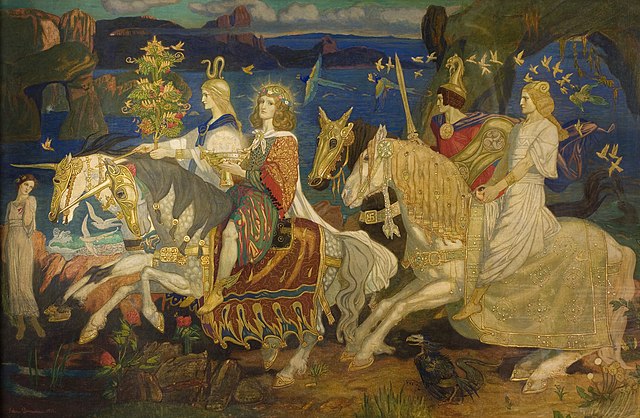It looks like you're using an Ad Blocker.
Please white-list or disable AboveTopSecret.com in your ad-blocking tool.
Thank you.
Some features of ATS will be disabled while you continue to use an ad-blocker.
share:
Hmmm, this has turned into more of a blog than a thread. More than just a simple discussion, and more than just putting down ideas and anecdotes. Of
course anyone can post at any time and I can enlarge on anything I write here.
I often say; It is all deceptively simple, and it really is. People like to complicate things, which is fine if one wants to immerse oneself in an intellectal dreamscape. Philosophy in all it's forms comes to mind here. People get lost very easily in those places.
Yet underlaying the philosophies, religions and other dreams are very simple fundamentals. It is these fundamentals that I describe as being decepively simple. One might call the fundamentals principals if one wishes.
As any cartographer will tell you; to create a map and to go forth exploring needs a beginning, a starting point. In the children's story of Hansel and Gretal, the children's parents tried to abandon them in the woods. Hansel was smart enough to leave a trail of breadcrumbs so he and his sister could find their way home again.
Home is an important word. Home is the starting point. We live in a physical body in a physical location in a physical world. We have laws of physics; the rules of how the world works. This is our home, and our starting point.
With this starting point in mind, everything I describe is from this orientation. I am me, I live in a small house on a quiet street in a small town in Western Australia. Everyone has a home.
We spend our nights sleeping and dreaming and afterwards wake up in our beds every morning.
This is important if we are to go adventuring and exploring what is 'out there'. We have to be able to find our way home again.
I often say; It is all deceptively simple, and it really is. People like to complicate things, which is fine if one wants to immerse oneself in an intellectal dreamscape. Philosophy in all it's forms comes to mind here. People get lost very easily in those places.
Yet underlaying the philosophies, religions and other dreams are very simple fundamentals. It is these fundamentals that I describe as being decepively simple. One might call the fundamentals principals if one wishes.
As any cartographer will tell you; to create a map and to go forth exploring needs a beginning, a starting point. In the children's story of Hansel and Gretal, the children's parents tried to abandon them in the woods. Hansel was smart enough to leave a trail of breadcrumbs so he and his sister could find their way home again.
Home is an important word. Home is the starting point. We live in a physical body in a physical location in a physical world. We have laws of physics; the rules of how the world works. This is our home, and our starting point.
With this starting point in mind, everything I describe is from this orientation. I am me, I live in a small house on a quiet street in a small town in Western Australia. Everyone has a home.
We spend our nights sleeping and dreaming and afterwards wake up in our beds every morning.
This is important if we are to go adventuring and exploring what is 'out there'. We have to be able to find our way home again.
The concept of home is really important.
In the physical world we have to be able to find our way home every time we leave our house. We don't want to be homeless.
In the psychic worlds, the dreamscapapes, we also have to be able to find our way home every time. We don't want to be psychically homeless.
Some people find that psychic/dream home in religion, some in the occult lodges, and some find it in the "newage dream".
Clubs and associations count in this too. In martial arts we become the martial artist and some even live the martial arts life. I did when young. The military life is a similar thing that people live within. So too the artistic or philosophical life.
So does work. what we do; our trade, working within a business. These can be seen as dreams within which we live. The dreams of ordinary waking consciousness in the physical world. What is the corporate mind if not a dreamscape into which people are indoctrinated, or "on-boarding" as the jargon calls it.
Welcome to the dream . . .
Get it?
We do it all the time, we look for the dream within which to live.
However, once inside the waking dream, we forget that there is an "outside".
I know a fellow who is quirky, he has his ways and manners which are a little bit different from other folks. A nice fellow. Then one day he went and saw a psychologist and was told he was "Asperger syndrome".
The fellow believed the psychologist and we watched something extraordinary happen to him.
He became the "Asperger syndrome" clinical description. The fellow actually became "educated" and conformed to the psychology's definition of "Asperger syndrome".
One can also say; the fellow found a dream to live within. The "science" of psychology created a description with a label to which the fellow conformed. Psychology changed him.
This is the problem with labels, labels come with a set of definitions.
Of course, the psychology is in itself a waking dream within which psychologists live. What grounds the dream of psychology in this world is having parts of it in common with how the human mind and behaviours work in life.
We see the same thing when people become religious or newagey, they become "educated" and conform to a waking dream.
Nothing wrong with that. I guess it is just a matter of how anti-social that dream is.
In the physical world we have to be able to find our way home every time we leave our house. We don't want to be homeless.
In the psychic worlds, the dreamscapapes, we also have to be able to find our way home every time. We don't want to be psychically homeless.
Some people find that psychic/dream home in religion, some in the occult lodges, and some find it in the "newage dream".
Clubs and associations count in this too. In martial arts we become the martial artist and some even live the martial arts life. I did when young. The military life is a similar thing that people live within. So too the artistic or philosophical life.
So does work. what we do; our trade, working within a business. These can be seen as dreams within which we live. The dreams of ordinary waking consciousness in the physical world. What is the corporate mind if not a dreamscape into which people are indoctrinated, or "on-boarding" as the jargon calls it.
Welcome to the dream . . .
Get it?
We do it all the time, we look for the dream within which to live.
However, once inside the waking dream, we forget that there is an "outside".
I know a fellow who is quirky, he has his ways and manners which are a little bit different from other folks. A nice fellow. Then one day he went and saw a psychologist and was told he was "Asperger syndrome".
The fellow believed the psychologist and we watched something extraordinary happen to him.
He became the "Asperger syndrome" clinical description. The fellow actually became "educated" and conformed to the psychology's definition of "Asperger syndrome".
One can also say; the fellow found a dream to live within. The "science" of psychology created a description with a label to which the fellow conformed. Psychology changed him.
This is the problem with labels, labels come with a set of definitions.
Of course, the psychology is in itself a waking dream within which psychologists live. What grounds the dream of psychology in this world is having parts of it in common with how the human mind and behaviours work in life.
We see the same thing when people become religious or newagey, they become "educated" and conform to a waking dream.
Nothing wrong with that. I guess it is just a matter of how anti-social that dream is.
Dreams are also seductive. Be they the dreams of the small boy who wants to be a fireman when he grows up, the girl who wants to be a dancer, or the
megalomaniac who wants to rule the world.
We know that there is something that survives after death. I know because live with the dead, and take care of many of them. My "Alice" among them. I like the world of the dead for many reasons, mostly I spose, because I am needed there. Not so much in this world of the living.
If we listen to the scriptures and teachings, we are told that the "other" world is the important place, along with those who reside there. The saints, so-called masters of the wisdom, adepts and so on. Something called "god" is said to reside there too.
Our physical world within which we reside in life is said to be the unimportant world. Persoanlly I disagree.
I disagree for many reasons of my own, and for one very practical observation:
A living human can do things that the deceased cannot do.
A living human being is born in a physical body without memories, without prior knowledge and everything is new.
So here is a riddle to solve, I will give the answer in a few posts time:
We know that there is something that survives after death. I know because live with the dead, and take care of many of them. My "Alice" among them. I like the world of the dead for many reasons, mostly I spose, because I am needed there. Not so much in this world of the living.
If we listen to the scriptures and teachings, we are told that the "other" world is the important place, along with those who reside there. The saints, so-called masters of the wisdom, adepts and so on. Something called "god" is said to reside there too.
Our physical world within which we reside in life is said to be the unimportant world. Persoanlly I disagree.
I disagree for many reasons of my own, and for one very practical observation:
A living human can do things that the deceased cannot do.
A living human being is born in a physical body without memories, without prior knowledge and everything is new.
So here is a riddle to solve, I will give the answer in a few posts time:
The Three Sacred Treasures Of The Mortal World.
There are three transcendental treasures to be found within this mortal world.
Two of these treasures can only be discovered once in a lifetime.
One must come before the other.
Only when the first two treasures are known, will the third treasure reveal itself to mortal eyes.
There are three transcendental treasures to be found within this mortal world.
Two of these treasures can only be discovered once in a lifetime.
One must come before the other.
Only when the first two treasures are known, will the third treasure reveal itself to mortal eyes.
edit on 18-2-2022 by NobodySpecial268 because: typo
Navigating The Dreamscapes - defining our home-port.
So, let's begin to create our map of the psychic realms; the dreamscapes. As all good cartographers do, we begin with our home-port; our sense of being me , the self as it exists in the physical body.
The simple dream.
Let's take the circle, a simple example of the dreamscape. When our sleeping mind creates a dream and ruminates the dramas of our waking day, we can say we create a simple dream. A sphere with the two dimensions of inside and outside.
We can represent the simple dream as a circle.
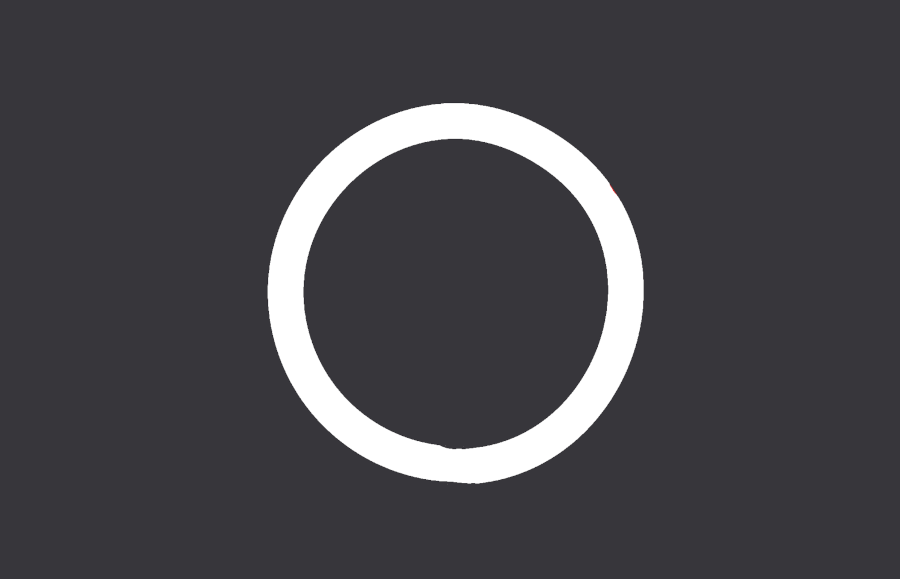
Now let's take our circle and put a twist in it to make the figure eight and lay it on it's side.

Now we place our two flower forms of the awake and the asleep human within the figure eight.

The point of twist is the point of the inversion of consciousness between awake and asleep.
This is really important that we appreciate this. In the so-called "schizophrenic" child one of the first things done was to work on waking up. We worked on making the inversion of consciousness from asleep to awake as clean as possible. Part of this process was to spend weeks every day within the childs dreamscape observing as the NPC (Non-Player Character). When our "patient" began to notice us, the request was made to wake up and put on her socks for school. The socks were chosen because the act of putting on socks was where the child spaced out regularly. There was a lot of ignorring my request and outright stubbornness, even to the point of being told "no!" That was the point the request was dropped.
At the same time, we were gradually changing the dreamscape with our presence. The "tormentor" and probably other things were not manefesting within the dreamscape. We were also cleaning up the accumulated misery that sits like soot upon the child within the dream, and the dreamscape itself. To use an analogy; the NPC was cleaning up the child's room around her to make it a safer and a more pleasant place. We do not work upon the child directly because we do not want to change the child's consciousness in any way.
It was perhaps with a month or so of cleaning up her subconscious room and her waking life, that the child decided for herself to successfully put on her socks without spacing out too much. That was the most wonderful news for me, via the girl's mother. It is signs of success in the physical world.
In gaming terms one might say; the child's subconscious decided for herself to accept the NPC's quest for socks.
The reason is this: In the presence of misery, happiness cannot manefest. Happiness is the natural state of the child's consciousness. Children are naturally happy to be alive. If we simply clean away the accumulated misery, happiness will naturally manefest.
If I were asked the most important thing to achieve in our "patient" it is to clean away the accumulated misery. Then everything else begins to resolve itself with help here and there in the waking life. The techniques of consciousness cleaning I will go into in time when we have covered the fundamentals. If you have been practicing the simple technique of holding the baby in your arms from earlier, well, you have already learned the fundamental technique.
The same technique of cleaning up misery I have found works upon the eating disorders, and the depression in the child where misery has lead to the light dimming in the child's eyes. Misery is what dims the light in the eyes. Clear that, and the light will return to the eyes. Remember though, you have to work on the physical waking life as well as the subconscious sleeping life. We also need to work towards solving the sources of misery in our child.
So we have the inversion of consciousness in the daily cycle of awakening, going to sleep, and waking up again next day.
Now we look at a longer cycle that can be said to be very similar; being alive and being dead.
So let's place our figure eight with the flower forms on it's side within the lower chamber of an upright figure eight.
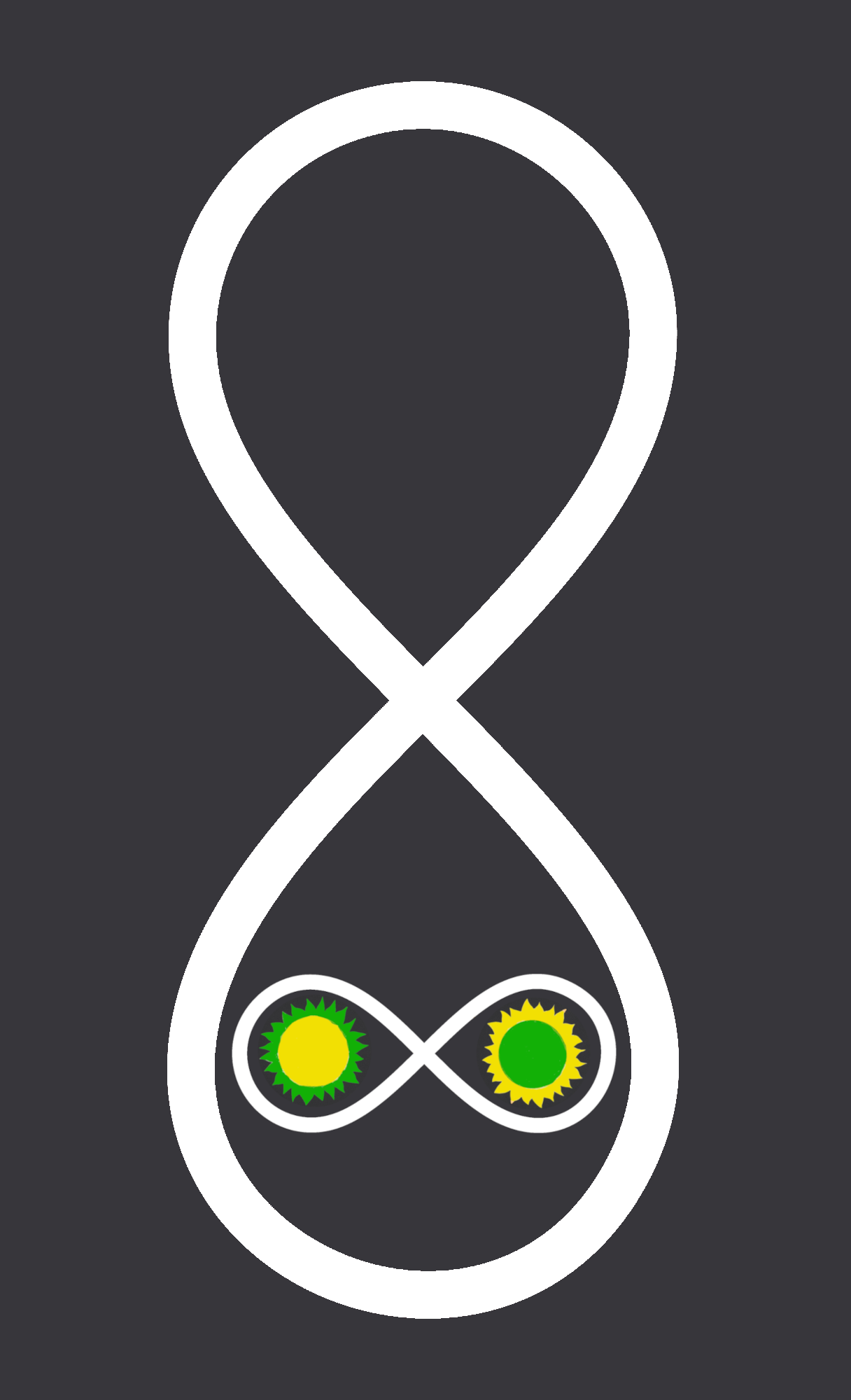
We can see how, on a larger scale how our consciousness can invert between the consciousness of the living and the consciousness of the deceased.
We can also use the figure eight as an analogy for the two worlds, the living and the dead. Keep in mind the association of the fairies and the dead from the folk lore. The suggestion here is we will find the fairy folk in the same places we will find the dead.
There is also the suggestion here that the fairy folk are to be found on the other side of the inversion of consciousness between awake and asleep, and the inversion of consciousness between alive and deceased.
It follows then, the so-called "veil between the worlds" is the inversion of consciousness that needs to be bridged if we are to be conscious of the the fairies, the fae, and the deceased.
In a practical sense, the point of consciousness inversion between sleep and awake is mirrored in the point of consciousness inversion seen in birth and death. Many troubles are to be found when the inversion of consciousness in the two cycles are disturbed.
Disturbances in the sleep cycles will cause people harm, sleep deprivation will eventually wreak the health of the mind and body, and doesn't really need enlarging here.
Disturbanceces in the death cycles will also cause people harm. Earlier in this thread I wrote of the deceased kids I have in my care. I also mentioned that they died traumatised. The traumas can carry over through the inversion of consciousness at death and into the afterlife. There is a "dark spiritual science" that can be seen in the Inquisitions of the church for example. Talented psychics and favorites of the fairies for instance, can be targeted life after life with the view that repeated torture, torment and death as children will create an antipathy towards living in the future. That is murder beyond murder, and the reason why I am so interested in these deceased children. The principals of healing of the so-called "schizophrenia" and similar difficulties in the living gives the principals and knowledge of the healing of traumas of the deceased. That will, I hope, give these deceased kids a second chance at life.
Healing the deceased is not as difficult as it would at first seem. For example the illness we call congenital Syphilis will cary over after death, and can be cured in the deceased quite quickly with the giving of the modern antibiotics in the same way as the vitamin C was administered a page or two ago. One can give the remedy directly to the deceased children in a teaspoon of honey if one is alergic to the antibiotics and wish to be careful of an alergic reaction in ourselves. By the way, the disease was designed to target the children of those infected and ruin their lives to come. A particularly cruel creation.
So just for completeness, let's place the image of a snowflake in the upper chamber of our figure eight.

The human memory grows from life to life in a very similair way to the formation of snowflakes.
Some may liken the snowflake memory to the notion of "soul".
Perhaps . . . . .
However, the notion of "soul" has so much baggage associated with it that I suggest discarding the concept as it is popularly conceived. Go discover for yourself is my suggestion. ~ it is only an inversion away.
So, let's begin to create our map of the psychic realms; the dreamscapes. As all good cartographers do, we begin with our home-port; our sense of being me , the self as it exists in the physical body.
The simple dream.
Let's take the circle, a simple example of the dreamscape. When our sleeping mind creates a dream and ruminates the dramas of our waking day, we can say we create a simple dream. A sphere with the two dimensions of inside and outside.
We can represent the simple dream as a circle.

Now let's take our circle and put a twist in it to make the figure eight and lay it on it's side.

Now we place our two flower forms of the awake and the asleep human within the figure eight.

The point of twist is the point of the inversion of consciousness between awake and asleep.
This is really important that we appreciate this. In the so-called "schizophrenic" child one of the first things done was to work on waking up. We worked on making the inversion of consciousness from asleep to awake as clean as possible. Part of this process was to spend weeks every day within the childs dreamscape observing as the NPC (Non-Player Character). When our "patient" began to notice us, the request was made to wake up and put on her socks for school. The socks were chosen because the act of putting on socks was where the child spaced out regularly. There was a lot of ignorring my request and outright stubbornness, even to the point of being told "no!" That was the point the request was dropped.
At the same time, we were gradually changing the dreamscape with our presence. The "tormentor" and probably other things were not manefesting within the dreamscape. We were also cleaning up the accumulated misery that sits like soot upon the child within the dream, and the dreamscape itself. To use an analogy; the NPC was cleaning up the child's room around her to make it a safer and a more pleasant place. We do not work upon the child directly because we do not want to change the child's consciousness in any way.
It was perhaps with a month or so of cleaning up her subconscious room and her waking life, that the child decided for herself to successfully put on her socks without spacing out too much. That was the most wonderful news for me, via the girl's mother. It is signs of success in the physical world.
In gaming terms one might say; the child's subconscious decided for herself to accept the NPC's quest for socks.
The reason is this: In the presence of misery, happiness cannot manefest. Happiness is the natural state of the child's consciousness. Children are naturally happy to be alive. If we simply clean away the accumulated misery, happiness will naturally manefest.
If I were asked the most important thing to achieve in our "patient" it is to clean away the accumulated misery. Then everything else begins to resolve itself with help here and there in the waking life. The techniques of consciousness cleaning I will go into in time when we have covered the fundamentals. If you have been practicing the simple technique of holding the baby in your arms from earlier, well, you have already learned the fundamental technique.
The same technique of cleaning up misery I have found works upon the eating disorders, and the depression in the child where misery has lead to the light dimming in the child's eyes. Misery is what dims the light in the eyes. Clear that, and the light will return to the eyes. Remember though, you have to work on the physical waking life as well as the subconscious sleeping life. We also need to work towards solving the sources of misery in our child.
So we have the inversion of consciousness in the daily cycle of awakening, going to sleep, and waking up again next day.
Now we look at a longer cycle that can be said to be very similar; being alive and being dead.
So let's place our figure eight with the flower forms on it's side within the lower chamber of an upright figure eight.

We can see how, on a larger scale how our consciousness can invert between the consciousness of the living and the consciousness of the deceased.
We can also use the figure eight as an analogy for the two worlds, the living and the dead. Keep in mind the association of the fairies and the dead from the folk lore. The suggestion here is we will find the fairy folk in the same places we will find the dead.
There is also the suggestion here that the fairy folk are to be found on the other side of the inversion of consciousness between awake and asleep, and the inversion of consciousness between alive and deceased.
It follows then, the so-called "veil between the worlds" is the inversion of consciousness that needs to be bridged if we are to be conscious of the the fairies, the fae, and the deceased.
In a practical sense, the point of consciousness inversion between sleep and awake is mirrored in the point of consciousness inversion seen in birth and death. Many troubles are to be found when the inversion of consciousness in the two cycles are disturbed.
Disturbances in the sleep cycles will cause people harm, sleep deprivation will eventually wreak the health of the mind and body, and doesn't really need enlarging here.
Disturbanceces in the death cycles will also cause people harm. Earlier in this thread I wrote of the deceased kids I have in my care. I also mentioned that they died traumatised. The traumas can carry over through the inversion of consciousness at death and into the afterlife. There is a "dark spiritual science" that can be seen in the Inquisitions of the church for example. Talented psychics and favorites of the fairies for instance, can be targeted life after life with the view that repeated torture, torment and death as children will create an antipathy towards living in the future. That is murder beyond murder, and the reason why I am so interested in these deceased children. The principals of healing of the so-called "schizophrenia" and similar difficulties in the living gives the principals and knowledge of the healing of traumas of the deceased. That will, I hope, give these deceased kids a second chance at life.
Healing the deceased is not as difficult as it would at first seem. For example the illness we call congenital Syphilis will cary over after death, and can be cured in the deceased quite quickly with the giving of the modern antibiotics in the same way as the vitamin C was administered a page or two ago. One can give the remedy directly to the deceased children in a teaspoon of honey if one is alergic to the antibiotics and wish to be careful of an alergic reaction in ourselves. By the way, the disease was designed to target the children of those infected and ruin their lives to come. A particularly cruel creation.
So just for completeness, let's place the image of a snowflake in the upper chamber of our figure eight.

The human memory grows from life to life in a very similair way to the formation of snowflakes.
Some may liken the snowflake memory to the notion of "soul".
Perhaps . . . . .
However, the notion of "soul" has so much baggage associated with it that I suggest discarding the concept as it is popularly conceived. Go discover for yourself is my suggestion. ~ it is only an inversion away.
edit on 19-2-2022 by NobodySpecial268 because: spelling mistakes
continued . . .
So we can understand how everyone is essentially unique.
Here is an animation of how a snowflake grows from a tiny speck to a complex geometric crystal form.
So very close to how a human memory grows . . .
Perhaps one might suggest: consciousness (space) is folded (and navigated) via the process of inversion.
The intricate shape of a single arm of the snowflake is determined by the atmospheric conditions experienced by entire ice crystal as it falls. A crystal might begin to grow arms in one manner, and then minutes or even seconds later, slight changes in the surrounding temperature or humidity causes the crystal to grow in another way. Although the six-sided shape is always maintained, the ice crystal (and its six arms) may branch off in new directions. Because each arm experiences the same atmospheric conditions, the arms look identical.
Q: So, why are no two snowflakes exactly alike?
A: Well, that’s because individual snowflakes all follow slightly different paths from the sky to the ground —and thus encounter slightly different atmospheric conditions along the way. Therefore, they all tend to look unique, resembling everything from prisms and needles to the familiar lacy pattern.
Source: How do snowflakes form? www.noaa.gov
So we can understand how everyone is essentially unique.
Here is an animation of how a snowflake grows from a tiny speck to a complex geometric crystal form.
So very close to how a human memory grows . . .
Perhaps one might suggest: consciousness (space) is folded (and navigated) via the process of inversion.
edit on 19-2-2022 by NobodySpecial268 because: fixed video URL
What else can I write about the "snowflake", and the trauma that is relevant here?
The "snowflake memory" is basically what I 'see'. It is a light blue, and is not made of frozen water. The description of how individual snowflakes form uniquely, is very much like how the random events and circumstance of life grow the unique person. In this way everyone is unique and no life will ever be exactly the same.
One can see people's talents as branches. The musician Mozart probably had a very well developed musical branch of his "snowflake". Therefore we can say that Mozart spent many lives with a love for music.
So, one may ask; Is talent a "gift"?
Well, the notion of a "gift from a god" does two things. One; it does make the untalented people feel better. Two; it denies the talented the idea that he or she may have put a great deal of very hard work into something they love to do.
In a way calling people "gifted" is sour grapes as is said in the English idiom meaning: disparagement of something that has proven unattainable (for some people). Atributing the "gift" to the benevolence of a god denies the hard work. No one likes the credit for their hard work given to someone or something else.
Dishonesty it is.
Trauma will appear in the snowflake as the black of misery at the tip where growth occurs. Trauma has the effect of killing the growth tip. This shows up in life as a deep seated aversion. The "dark spiritual science" knows this, Black Psychology of the soul is another way to call it.
The "snowflake memory" is basically what I 'see'. It is a light blue, and is not made of frozen water. The description of how individual snowflakes form uniquely, is very much like how the random events and circumstance of life grow the unique person. In this way everyone is unique and no life will ever be exactly the same.
One can see people's talents as branches. The musician Mozart probably had a very well developed musical branch of his "snowflake". Therefore we can say that Mozart spent many lives with a love for music.
So, one may ask; Is talent a "gift"?
Well, the notion of a "gift from a god" does two things. One; it does make the untalented people feel better. Two; it denies the talented the idea that he or she may have put a great deal of very hard work into something they love to do.
In a way calling people "gifted" is sour grapes as is said in the English idiom meaning: disparagement of something that has proven unattainable (for some people). Atributing the "gift" to the benevolence of a god denies the hard work. No one likes the credit for their hard work given to someone or something else.
Dishonesty it is.
Trauma will appear in the snowflake as the black of misery at the tip where growth occurs. Trauma has the effect of killing the growth tip. This shows up in life as a deep seated aversion. The "dark spiritual science" knows this, Black Psychology of the soul is another way to call it.
edit on 20-2-2022 by NobodySpecial268 because: spelling correction
Let's continue our exercise in the cartography of human consciousness.
Know thyself is said to have been written in the forecourt of the Temple of Apollo at Delphi.
"Know thy measure". How apropriate for an exercise in cartography.
. . . and:
Cogito, ergo sum - "I think therefore I am." ~ René Descartes.
To mister Descartes I would simply say; there is more to man than thought alone.
"I think, I feel, I have memories, therefore I am." would be my reply to him.
Three posts above, the figure eight within a figure eight is a triplicity: the memory, the subconscious and the conscious. If this sounds familiar, I would simply say; beware of imitations . . .
So to know thy measure can be said to say; know thy boundary - the boundary of the self.
When you know your boundary, we have two dimensions the inside (me) and the outside (not me).
So our map has a home-port; the me. As every cartographer knows the unexplored is marked; "here be dragons".
Know thyself is said to have been written in the forecourt of the Temple of Apollo at Delphi.
The maxim, or aphorism, "know thyself" has had a variety of meanings attributed to it in literature, and over time, as in early ancient Greek the phrase meant "know thy measure".
Source: wikipedia
"Know thy measure". How apropriate for an exercise in cartography.
. . . and:
Cogito, ergo sum - "I think therefore I am." ~ René Descartes.
To mister Descartes I would simply say; there is more to man than thought alone.
"I think, I feel, I have memories, therefore I am." would be my reply to him.
Three posts above, the figure eight within a figure eight is a triplicity: the memory, the subconscious and the conscious. If this sounds familiar, I would simply say; beware of imitations . . .
So to know thy measure can be said to say; know thy boundary - the boundary of the self.
When you know your boundary, we have two dimensions the inside (me) and the outside (not me).
So our map has a home-port; the me. As every cartographer knows the unexplored is marked; "here be dragons".
edit on 24-2-2022 by NobodySpecial268 because: typo
A human Being is a physical being with consciousness. So let's place our triplicity into the circle.
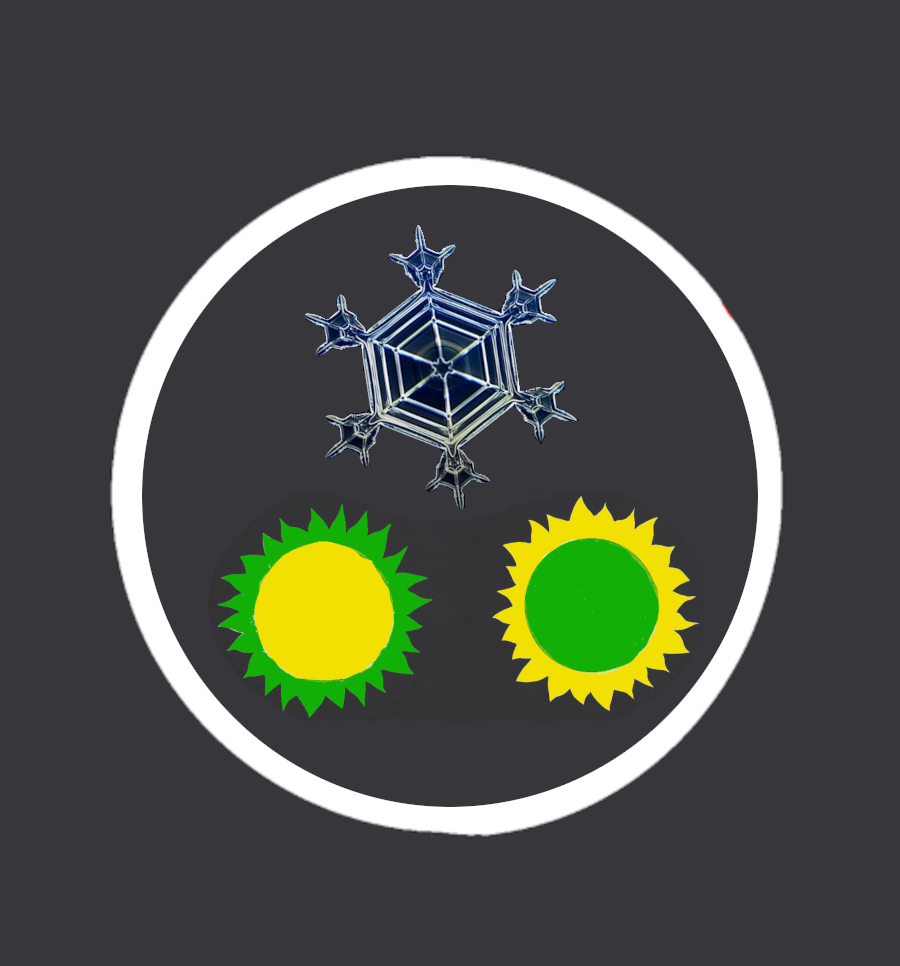
(Alt: the two flower forms with the blue snowflake within a circle.)
Now we place our conscious triplicity into a silhouette of our girl "Alice".
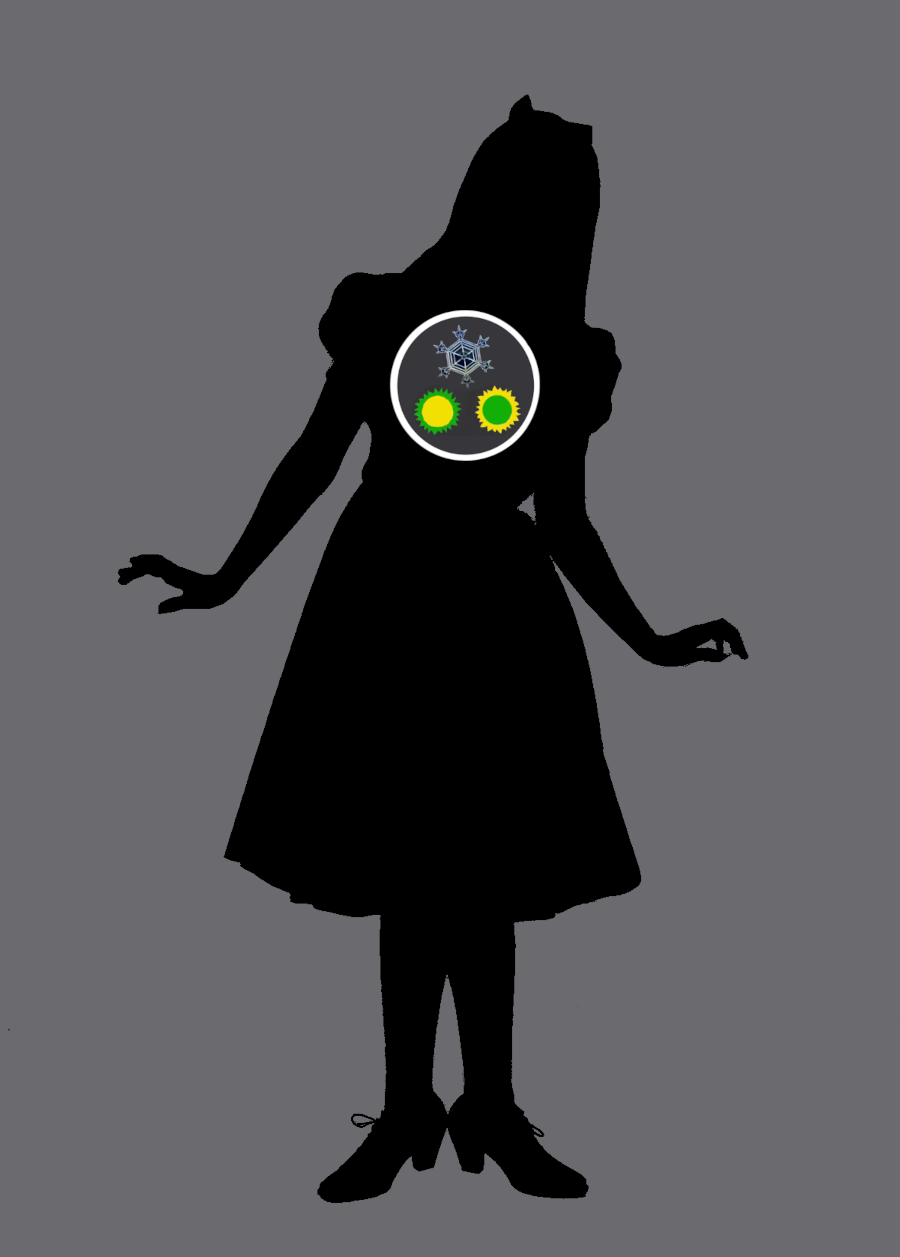
We should not forget that the human body has a very long history of it's own, millions of years of evolution it is said. The consciousness of the body's organs and systems are there too. The metabolism and more according to physiology.
Now we can begin to appreciate the complexcity and depth of our human consciousness as it resides within the body. Our body is our home.
The often stated know thyself, and know thy measure take on more meaning in this regard.
We should not forget the eye in the palms of the hands nor the body's images in the feet that we know from the reflexology mentioned earlier here. I also mentioned there that in a sense the human is a mobile tree were roots to extend from the soles of the feet through the reflexology points.
Let's revisit The Old Man and the Tree of Life
The Old Man and the Tree of Life
Where is this tree pray tell? Upon which mystic mountaintop did you glimpse such high heavens of arcane knowledge?
Do not waste your time upon the mountain top. If it is a tree you seek, you will not find it there.
The temple? A shrine? Which one? I must know!
That too is a waste of time young man if you truly want to know.
Who has this knowledge? Where are they to be found?
My advice to you young man is to go home and marry your girl. On your wedding night; you will find your tree.
You are mad old man! Nothing do you know!
The young man stomped off in disgust and joined a monastery in the hope that suffering and abstinence will show him the way. The old man simply smiled and went home to his family and evening meal. Some time later the two meet again.
Tell me old man! Where can I find this tree!
The old man thought for a moment.
Twas the fairy folk who showed me this. . . . .
The fruit of a tree of life . . . .
is hidden . . . .
behind the veil . . . .
of a maiden's skirt.
A maiden's womb is simply the fruit of a tree.
If you want to know the secrets of life young man, go home and marry your girl.
(Source: well that would be me : )
We should be getting an idea of what a human is. Or perhaps we should say; what a human was.
Ol' Rudolph Stiener said; The Beings of Nature used to inhabit the organs of the body, and will again.
So that is what is currently missing from our human being. Were those Beings still within us, we would also have the knowing of Nature.
Let's next venture into the realm of the dreamscapes in search of fairies.

(Alt: the two flower forms with the blue snowflake within a circle.)
Now we place our conscious triplicity into a silhouette of our girl "Alice".

We should not forget that the human body has a very long history of it's own, millions of years of evolution it is said. The consciousness of the body's organs and systems are there too. The metabolism and more according to physiology.
Now we can begin to appreciate the complexcity and depth of our human consciousness as it resides within the body. Our body is our home.
The often stated know thyself, and know thy measure take on more meaning in this regard.
We should not forget the eye in the palms of the hands nor the body's images in the feet that we know from the reflexology mentioned earlier here. I also mentioned there that in a sense the human is a mobile tree were roots to extend from the soles of the feet through the reflexology points.
Let's revisit The Old Man and the Tree of Life
The Old Man and the Tree of Life
Where is this tree pray tell? Upon which mystic mountaintop did you glimpse such high heavens of arcane knowledge?
Do not waste your time upon the mountain top. If it is a tree you seek, you will not find it there.
The temple? A shrine? Which one? I must know!
That too is a waste of time young man if you truly want to know.
Who has this knowledge? Where are they to be found?
My advice to you young man is to go home and marry your girl. On your wedding night; you will find your tree.
You are mad old man! Nothing do you know!
The young man stomped off in disgust and joined a monastery in the hope that suffering and abstinence will show him the way. The old man simply smiled and went home to his family and evening meal. Some time later the two meet again.
Tell me old man! Where can I find this tree!
The old man thought for a moment.
Twas the fairy folk who showed me this. . . . .
The fruit of a tree of life . . . .
is hidden . . . .
behind the veil . . . .
of a maiden's skirt.
A maiden's womb is simply the fruit of a tree.
If you want to know the secrets of life young man, go home and marry your girl.
(Source: well that would be me : )
We should be getting an idea of what a human is. Or perhaps we should say; what a human was.
Ol' Rudolph Stiener said; The Beings of Nature used to inhabit the organs of the body, and will again.
So that is what is currently missing from our human being. Were those Beings still within us, we would also have the knowing of Nature.
Let's next venture into the realm of the dreamscapes in search of fairies.
edit on 25-2-2022 by NobodySpecial268 because: major glitch and added a few lines to the end of the post
As often happens, the fairies and other fae will join me in the evenings when I have coffee and smoke on my front veranda. Here in country Australia we have our "little people". The native folks, the Nyungar people, call them 'mummeries'. The lore is mostly oral, as far as I know. One has to listen and talk to the older folks to hear the lore. I did find a reference to mummeries in a government environmental PDF.
----------------
Some of the informants talked about Mummeries, small spirit people who were able to cause trouble and were often mischievous. If people do bad things the Mummeries would cause trouble for the custodians of the country, these spirits are all across the country and they are letting Nyungar people know that they are not doing their job of looking after the country. The custodians of the country had to try and put something back into the country, it was their duty to protect and preserve good areas of ‘bush tucker’.
Source: A SURVEY OF ABORIGINAL SOCIAL WATER REQUIREMENTS FOR THE SOUTHERN BLACKWOOD PLATEAU AND SCOTT COASTAL PLAIN, SOUTHWEST, WESTERN AUSTRALIA
I see their eyes glowing in the trees at night when the light is right. I suspect they are the little folk who sometimes rummage through my house in the middle of the night.
Talking with the local Nyungar folk, the suggestion was they may be looking for food, or something that takes their interest. It reminds me so much of the British fairy lore of leaving a saucer of milk for the Brownies. The mummeries live amongst the trees in the wild place next to my house, I never go in there unless I absolutly need to.
The little folk, the mummeries, have little spears. They come closer these nights and listen in on my conversations with other intangiable folk.
edit on 25-2-2022 by NobodySpecial268 because: clarity
So much needs to be said on the subject of the faires and the fae, what a human being is and more importantly; what is not. Even before we set forth
looking for the faires, so much needs to be said. There is more intertest now from the unseen folk in what I write here. So let's dally a little more.
Last night I was seated on my verandah thinking of this thread and how I would describe what I see out there in the shared interactive dreamscapes - the collective consciousnesses. The so-called "illuminati" are there, as are the western occultists. They have their places where their consciousnesses live; their collective dreamscapes that overlay their waking states. The kabbalah is there in all it's infamous glory, as are the tarots and other things. So are the Cthulhu (plueral) of Lovecrafts fictional stories.
Then there are the universities, the places of occult learning. Very busy these dreamscape places are. I sometimes stand at the enterance to one of these universities in the foyer lite up with bright orange golden light. Two curved staircases there are, arranged (I suspect) in a double helix. The place reminds me of the Caduceaus symbol of medical and esoteric lore. Wikipedia has some interesting things to say about how the symbol is (mis)used.. My guess is the structure of the staircases in the occult dreamscape is structured to represent "wisdom" to the people who go there in their sleep.
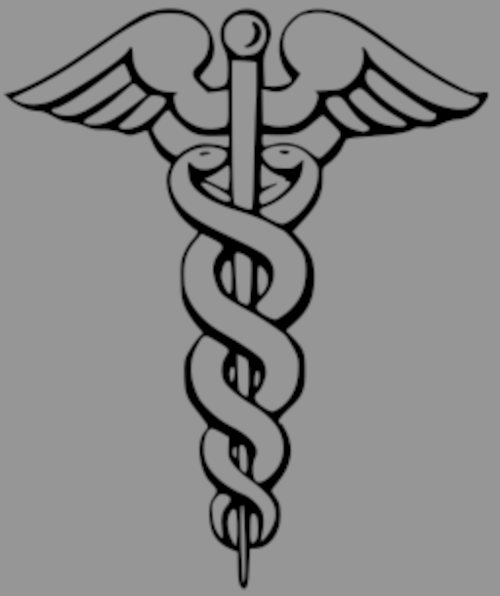
(Alt: Image shows a central staff with wings atop. Two snakes entwine the staff. Image is public domain)
A real correspondance to the human spinal nervous system including the head is my educated suspicion. What they study in there I do not know. One could wander up those stairs and snoop for oneself, but what the hell for.
The collective consciousness dreamscapes are constructed in this way.
These dreamscapes are surrounded within a boundary, and stand alone in the dreamworld. I guess there must be some security to unauthorised intrusion, the occult lodges are built that way. Personally I have a knack of crossing boundaries and mantrums without noticing, a knack that gets me into considerable trouble.
Last night I was seated on my verandah thinking of this thread and how I would describe what I see out there in the shared interactive dreamscapes - the collective consciousnesses. The so-called "illuminati" are there, as are the western occultists. They have their places where their consciousnesses live; their collective dreamscapes that overlay their waking states. The kabbalah is there in all it's infamous glory, as are the tarots and other things. So are the Cthulhu (plueral) of Lovecrafts fictional stories.
Then there are the universities, the places of occult learning. Very busy these dreamscape places are. I sometimes stand at the enterance to one of these universities in the foyer lite up with bright orange golden light. Two curved staircases there are, arranged (I suspect) in a double helix. The place reminds me of the Caduceaus symbol of medical and esoteric lore. Wikipedia has some interesting things to say about how the symbol is (mis)used.. My guess is the structure of the staircases in the occult dreamscape is structured to represent "wisdom" to the people who go there in their sleep.

(Alt: Image shows a central staff with wings atop. Two snakes entwine the staff. Image is public domain)
A real correspondance to the human spinal nervous system including the head is my educated suspicion. What they study in there I do not know. One could wander up those stairs and snoop for oneself, but what the hell for.
The collective consciousness dreamscapes are constructed in this way.
These dreamscapes are surrounded within a boundary, and stand alone in the dreamworld. I guess there must be some security to unauthorised intrusion, the occult lodges are built that way. Personally I have a knack of crossing boundaries and mantrums without noticing, a knack that gets me into considerable trouble.
edit on 26-2-2022 by NobodySpecial268 because: neatness
While on the subject of symbols and human consciousness, I'll relate a conversation with a young fairy girl last night. So I'll take a well known
religious/esoteric symbol and give the fairy view of what the symbol means.
* It is said in the fairy lore that fairies fear iron and they can be warded off by the metal.
* It is said in the religious lore that fairies, fae and so-called daemons flee when the word "jesus" is spoken.
A young fairy girl explained that to me last night.
Why would fairies have an aversion to iron, and flee from the word "jesus"?
The symbol for this explanation is the crucifix.
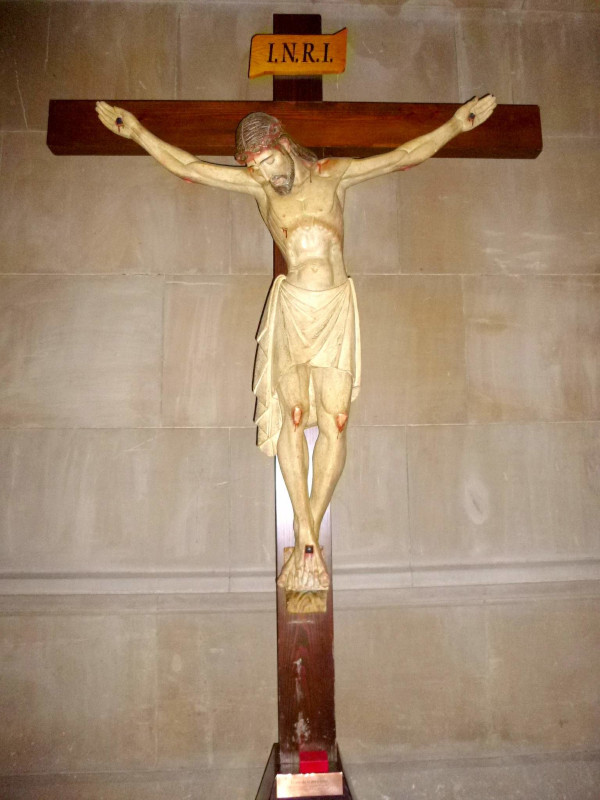
(Image is public domain. Image is of a crucifix, a man nailed to a cross.)
The young fairy girl explained the crucifix is a danger sign with dire consequences if not headed.
Why is that?
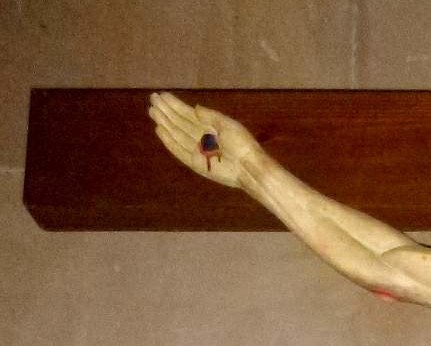
(image is public domain. Close up of image above showing iron nail through the palm of the hand.)
Remember what I said about the eye in the palm of the hand?
And now the feet.
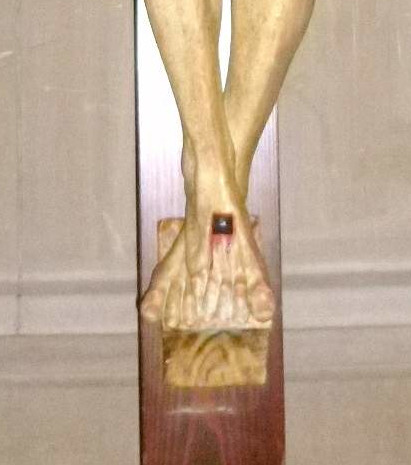
(image is public domain. Close up of image above showing iron nail through the top of the feet.)
Remember what I said about the image of the body in the soles of the feet and how the reflexology shows the organs of the body?
So what we have in the fairy's eyes is a tortured human being with iron nails through the psychic eyes of perception in the hands and the connection with the earth and Nature in the feet.
To the fairy the crucifix is not a direct threat to the fairy, rather it is a threat of what will happen to the human child who is favorite of the fairy. Not crucification per se, but the threat of cruelty inflicted by the church's followers upon the human friends of fairies in the past.
That is a fairy girl's interpretation of the symbol that is a crucifix, and the word that goes with it; "jesus".
The only power the symbol and the word has over the fairies and fae is triggering the memories of cruelty. The psychology of terrorism, torture and trauma.
The symbol has no occult, esoteric nor religious power over the fairies and the fae. That symbol and that word are nothing more than a sign saying "Danger - Keep Out".

(Image is public domain. A sign saying danger keep out.)
* It is said in the fairy lore that fairies fear iron and they can be warded off by the metal.
* It is said in the religious lore that fairies, fae and so-called daemons flee when the word "jesus" is spoken.
A young fairy girl explained that to me last night.
Why would fairies have an aversion to iron, and flee from the word "jesus"?
The symbol for this explanation is the crucifix.

(Image is public domain. Image is of a crucifix, a man nailed to a cross.)
The young fairy girl explained the crucifix is a danger sign with dire consequences if not headed.
Why is that?

(image is public domain. Close up of image above showing iron nail through the palm of the hand.)
Remember what I said about the eye in the palm of the hand?
And now the feet.

(image is public domain. Close up of image above showing iron nail through the top of the feet.)
Remember what I said about the image of the body in the soles of the feet and how the reflexology shows the organs of the body?
So what we have in the fairy's eyes is a tortured human being with iron nails through the psychic eyes of perception in the hands and the connection with the earth and Nature in the feet.
To the fairy the crucifix is not a direct threat to the fairy, rather it is a threat of what will happen to the human child who is favorite of the fairy. Not crucification per se, but the threat of cruelty inflicted by the church's followers upon the human friends of fairies in the past.
That is a fairy girl's interpretation of the symbol that is a crucifix, and the word that goes with it; "jesus".
The only power the symbol and the word has over the fairies and fae is triggering the memories of cruelty. The psychology of terrorism, torture and trauma.
The symbol has no occult, esoteric nor religious power over the fairies and the fae. That symbol and that word are nothing more than a sign saying "Danger - Keep Out".

(Image is public domain. A sign saying danger keep out.)
edit on 26-2-2022 by NobodySpecial268 because: neatness
When the fairies and fae say something it is generally not idle chitchat, for me at least. They expect me to look deeper to 'unpack' what is said.
There is always a reason.
The nails through the psychic eyes in the hands are fairly obvious; blindness. Yet there is a little more to the symbol of the iron nail through the eye.
I've mentioned that the human subconscious knows a great deal, and that the physical body knows how to do interesting things. When I use the eyes in the hands for the healing, it is in a certain way.
What material science has to say:
Metabolism is the chemical reactions in the body's cells that change food into energy.
We also have:
Catabolism is the set of metabolic processes that break down large molecules.
Anabolism is the process by which the body utilizes the energy released by catabolism to synthesize complex molecules.
When I wish to separate two or more things, say removing misery from a child, it is the breaking down process that I use through the left hand.
When I wish to build or combine, say giving vitamin C to a child, it is the combining and building process that I use through the right hand.
So, as a right handed person, the left hand's eye separates, and the right hand's eye builds. The natural bodily processes of destruction and creation. (In the left handed person perhaps it is reversed.)
That is an example of using the physical body's unconscious knowledge and abilities for healing. So I wonder why someone or something would desire to "discourage" this knowledge . . . . ?
The nail through the feet is through the connection to the earth. Perhaps to create a disconnection? And the yoga lotus position where the legs are crossed and the soles of the feet point upwards instead of down.

(image is public domain)
In the image above, we have from left to right; Shiva and Bhudda in the lotus position. On the right is the feet with the nail. Perhaps just a coincidence?
Now here is another image. The legs of the god Vishnu depicting earth and the six realms of Patala. The feet rest on Shesha.
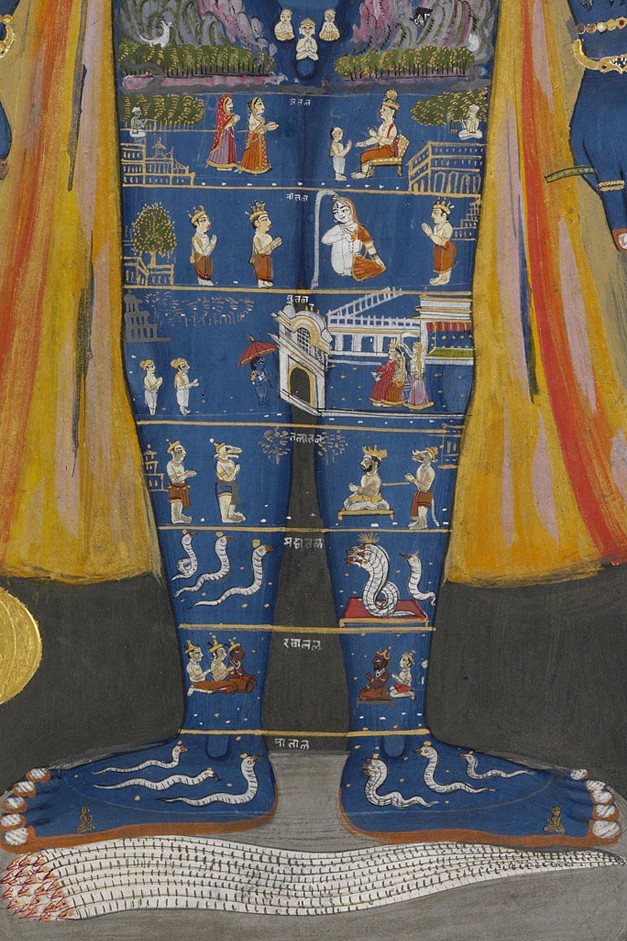
(image is public domain)
Coincidentally, in the British fairy folk lore, the fairies are said to reside in places below ground. The Tuatha Dé Danann, a supernatural race in Irish mythology are said to have settled below ground after loosing a "war".
So why hide or discourage the connection with the earth? I can only wonder if it is to keep the eyes elsewhere . . .
The nails through the psychic eyes in the hands are fairly obvious; blindness. Yet there is a little more to the symbol of the iron nail through the eye.
I've mentioned that the human subconscious knows a great deal, and that the physical body knows how to do interesting things. When I use the eyes in the hands for the healing, it is in a certain way.
What material science has to say:
Metabolism is the chemical reactions in the body's cells that change food into energy.
We also have:
Catabolism is the set of metabolic processes that break down large molecules.
Anabolism is the process by which the body utilizes the energy released by catabolism to synthesize complex molecules.
When I wish to separate two or more things, say removing misery from a child, it is the breaking down process that I use through the left hand.
When I wish to build or combine, say giving vitamin C to a child, it is the combining and building process that I use through the right hand.
So, as a right handed person, the left hand's eye separates, and the right hand's eye builds. The natural bodily processes of destruction and creation. (In the left handed person perhaps it is reversed.)
That is an example of using the physical body's unconscious knowledge and abilities for healing. So I wonder why someone or something would desire to "discourage" this knowledge . . . . ?
The nail through the feet is through the connection to the earth. Perhaps to create a disconnection? And the yoga lotus position where the legs are crossed and the soles of the feet point upwards instead of down.

(image is public domain)
In the image above, we have from left to right; Shiva and Bhudda in the lotus position. On the right is the feet with the nail. Perhaps just a coincidence?
Now here is another image. The legs of the god Vishnu depicting earth and the six realms of Patala. The feet rest on Shesha.

(image is public domain)
In Indian religions, Patala (that which is below the feet), denotes the subterranean realms of the universe – which are located under the earthly dimension. Patala is often translated as underworld or netherworld. Patala is described as more beautiful than Svarga (subtle dimensions, loosely translated as heaven). Patala is described as filled with splendid jewels, beautiful groves and lakes.
Source: Wikipedia
Coincidentally, in the British fairy folk lore, the fairies are said to reside in places below ground. The Tuatha Dé Danann, a supernatural race in Irish mythology are said to have settled below ground after loosing a "war".
Much of Irish mythology was recorded by Christian monks, who modified it to an extent. They often depicted the Tuath Dé as kings, queens and heroes of the distant past who had supernatural powers. Other times they were explained as fallen angels who were neither good nor evil. However, some medieval writers acknowledged that they were gods.
The Tuath Dé eventually became the Aos Sí or "fairies" of later folklore.
Aos sí older form: aes sídhe) is the Irish name for a supernatural race in Celtic mythology – spelled sìth by the Scots, but pronounced the same – comparable to fairies or elves. They are said to descend from either fallen angels or the Tuatha Dé Danann, meaning the "People of Danu", depending on the Abrahamic or pagan tradition.
Source: Wikipedia
So why hide or discourage the connection with the earth? I can only wonder if it is to keep the eyes elsewhere . . .
edit on 28-2-2022 by NobodySpecial268 because: neatness
a reply to: NobodySpecial268
The way it unfolded for me when contemplating that thought once; it seems the religious Gods are from humans and for humans only. They have decided to rise up and "save" humanity by separating them from years of ownership and belonging to other beings sharing the universe, dating the years B.C. which was not always a positive association [No personal opinion on this, just an observation, an explanation of the thought process that appears to be in action].
It seems humans are at the whim of others, puppeteers of other beings that are more powerful and who have their way with humans. It seems like there was a point where those who created the religion said, "enough".
These religions appear to have risen and laid out a strategy to rid this association and decrease the power of other beings. The strategy appears to be at least 2 folds (perhaps more). Fold 1: By creating new areas of focus for humans leveraging the power of creation described more below and; fold 2: removing access of the other beings to the human by sealing the lines of communication between humans and other beings, also described below.
Religions seem to be executing this strategy, by leveraging at least 2 of the many abilities within a human.
1. The power of creation and manifestation in free will (not just the womb - though the womb is most potent).
2. The power of lack of awareness of a human.
If this inclination is true, there would likely be many other points being leveraged that I cannot perceive readily [this analysis would only be a drop in the ocean].
The first item, the power of creation in free will, is referring to the power of creation that only a live human has. This isn't just sheltering other life through the womb, but also sheltering other life in the physical world, through the creation or hosting of a home or other simple tasks such as planting a fruit. Creating a piece of art that can unpin an avalanche of change. In the same manner, living humans also can make religions real and true using that power. That is why faith is the most important pillar in a religion, it invokes the human's power of creation.
The second item, the power of lack of awareness is utilizing the power of removing something from its material existence for the humans. By removing human awareness from anything, the item lacking awareness ceases to exist for that human. Like limelight on a stage, everything around the limelight (representing awareness) is dark. Cumulatively, something can cease to exist for the entirety of humanity, if humanity collaborates on that focus shift. Something along the lines of - if a tree fell in the forest and no one heard it make a sound, did it really make a sound? Like if one of your kids is making a lot of noise; you might tell your other kid "ignore your sibling, soon you won't be able to hear their intrusion".
This strategy seems indeed, intended to
How does nailing the eyes in the palm or the connection to earth help this strategy?
The palms and the connection to the earth, in addition to other points in the body, are ley lines for which these beings' can access a human. Religion recommends nailing those access points, shut. The severing of the ley lines is one of many access points (including chakras) that would need to be cut off, to achieve the end game of religion, minimizing the access/influence of those other beings and shifting the energy to the creation of a consciousness that is strictly human.
Just some backward engineering analysis - I dunno
So why hide or discourage the connection with the earth? I can only wonder if it is to keep the eyes elsewhere
The way it unfolded for me when contemplating that thought once; it seems the religious Gods are from humans and for humans only. They have decided to rise up and "save" humanity by separating them from years of ownership and belonging to other beings sharing the universe, dating the years B.C. which was not always a positive association [No personal opinion on this, just an observation, an explanation of the thought process that appears to be in action].
It seems humans are at the whim of others, puppeteers of other beings that are more powerful and who have their way with humans. It seems like there was a point where those who created the religion said, "enough".
These religions appear to have risen and laid out a strategy to rid this association and decrease the power of other beings. The strategy appears to be at least 2 folds (perhaps more). Fold 1: By creating new areas of focus for humans leveraging the power of creation described more below and; fold 2: removing access of the other beings to the human by sealing the lines of communication between humans and other beings, also described below.
Religions seem to be executing this strategy, by leveraging at least 2 of the many abilities within a human.
1. The power of creation and manifestation in free will (not just the womb - though the womb is most potent).
2. The power of lack of awareness of a human.
If this inclination is true, there would likely be many other points being leveraged that I cannot perceive readily [this analysis would only be a drop in the ocean].
The first item, the power of creation in free will, is referring to the power of creation that only a live human has. This isn't just sheltering other life through the womb, but also sheltering other life in the physical world, through the creation or hosting of a home or other simple tasks such as planting a fruit. Creating a piece of art that can unpin an avalanche of change. In the same manner, living humans also can make religions real and true using that power. That is why faith is the most important pillar in a religion, it invokes the human's power of creation.
The second item, the power of lack of awareness is utilizing the power of removing something from its material existence for the humans. By removing human awareness from anything, the item lacking awareness ceases to exist for that human. Like limelight on a stage, everything around the limelight (representing awareness) is dark. Cumulatively, something can cease to exist for the entirety of humanity, if humanity collaborates on that focus shift. Something along the lines of - if a tree fell in the forest and no one heard it make a sound, did it really make a sound? Like if one of your kids is making a lot of noise; you might tell your other kid "ignore your sibling, soon you won't be able to hear their intrusion".
This strategy seems indeed, intended to
keep the eyes elsewhere
How does nailing the eyes in the palm or the connection to earth help this strategy?
The palms and the connection to the earth, in addition to other points in the body, are ley lines for which these beings' can access a human. Religion recommends nailing those access points, shut. The severing of the ley lines is one of many access points (including chakras) that would need to be cut off, to achieve the end game of religion, minimizing the access/influence of those other beings and shifting the energy to the creation of a consciousness that is strictly human.
Just some backward engineering analysis - I dunno
a reply to: jannybobani9
Hi ya janny, been a while . . .
Yah, if one looks at the prophets in terms of them being reformers, well then one can (academically) backtrace where the problems theoretically were. For instance where the practice of magic is forbidden.
And really I wouldn't disagree with your reasoning below, I can see instances of that too. Though you are far more positive outlooked (diplomatic?) than I.
And here too, I would not disagree.
I would suggest that the body's native consciousness when connected to the earth is very mature. Far older than the consciousness that co-habits the body during life. If I were to clarify here I would suggest the "blue snowflake memory" is far younger than the body. One can see that in the consciousness that can step forward from the "snowflake". They are , as far as I have seen, human children who have not even reached emotional puberty. As an example "Alice" is perhaps the equivalent of a nine or ten year old human girl as we ordinarily judge emotional/chronological age.
By comparrison, Alice says I am the equivalent of a five year old boy . . . (I guess I have to take her word for that ; )
That kinda makes humans the newcommers to this world.
The reason behind this point of view is that when one looks into the "snowflake memory" one sees a tiny speck of a seed within that is best explained by the analogy of how the ordinary snowflake forms from a speck of dust. The central speck being a very simple desire to exist in this Euclidean space and time.
One must keep in mind that being born in a body is not the only way to come to this world. Organic physical life takes that route. Others come in a different way, they simply manefest through the boundaries of human dreams, including the collective dreams. The one's I've watched have a simple desire to exist. Unfornunately misery is often all they have to build themselves from. Even the ones who remind me of Cthulhu began from a desire to exist.
That aside, I can think of a reason to demote the body's connection to the earth (notice I didn't say "our" connection to the earth).
Perhaps if people had access to the body's natural knowledge they would not need religion?
Hi ya janny, been a while . . .
The way it unfolded for me when contemplating that thought once; it seems the religious Gods are from humans and for humans only. They have decided to rise up and "save" humanity by separating them from years of ownership and belonging to other beings sharing the universe, dating the years B.C. which was not always a positive association [No personal opinion on this, just an observation, an explanation of the thought process that appears to be in action].
Yah, if one looks at the prophets in terms of them being reformers, well then one can (academically) backtrace where the problems theoretically were. For instance where the practice of magic is forbidden.
And really I wouldn't disagree with your reasoning below, I can see instances of that too. Though you are far more positive outlooked (diplomatic?) than I.
It seems humans are at the whim of others, puppeteers of other beings that are more powerful and who have their way with humans. It seems like there was a point where those who created the religion said, "enough".
These religions appear to have risen and laid out a strategy to rid this association and decrease the power of other beings. The strategy appears to be at least 2 folds (perhaps more). Fold 1: By creating new areas of focus for humans leveraging the power of creation described more below and; fold 2: removing access of the other beings to the human by sealing the lines of communication between humans and other beings, also described below.
Religions seem to be executing this strategy, by leveraging at least 2 of the many abilities within a human.
1. The power of creation and manifestation in free will (not just the womb - though the womb is most potent).
2. The power of lack of awareness of a human.
If this inclination is true, there would likely be many other points being leveraged that I cannot perceive readily [this analysis would only be a drop in the ocean].
The first item, the power of creation in free will, is referring to the power of creation that only a live human has. This isn't just sheltering other life through the womb, but also sheltering other life in the physical world, through the creation or hosting of a home or other simple tasks such as planting a fruit. Creating a piece of art that can unpin an avalanche of change. In the same manner, living humans also can make religions real and true using that power. That is why faith is the most important pillar in a religion, it invokes the human's power of creation.
And here too, I would not disagree.
The palms and the connection to the earth, in addition to other points in the body, are ley lines for which these beings' can access a human. Religion recommends nailing those access points, shut. The severing of the ley lines is one of many access points (including chakras) that would need to be cut off, to achieve the end game of religion, minimizing the access/influence of those other beings and shifting the energy to the creation of a consciousness that is strictly human.
I would suggest that the body's native consciousness when connected to the earth is very mature. Far older than the consciousness that co-habits the body during life. If I were to clarify here I would suggest the "blue snowflake memory" is far younger than the body. One can see that in the consciousness that can step forward from the "snowflake". They are , as far as I have seen, human children who have not even reached emotional puberty. As an example "Alice" is perhaps the equivalent of a nine or ten year old human girl as we ordinarily judge emotional/chronological age.
By comparrison, Alice says I am the equivalent of a five year old boy . . . (I guess I have to take her word for that ; )
That kinda makes humans the newcommers to this world.
The reason behind this point of view is that when one looks into the "snowflake memory" one sees a tiny speck of a seed within that is best explained by the analogy of how the ordinary snowflake forms from a speck of dust. The central speck being a very simple desire to exist in this Euclidean space and time.
One must keep in mind that being born in a body is not the only way to come to this world. Organic physical life takes that route. Others come in a different way, they simply manefest through the boundaries of human dreams, including the collective dreams. The one's I've watched have a simple desire to exist. Unfornunately misery is often all they have to build themselves from. Even the ones who remind me of Cthulhu began from a desire to exist.
That aside, I can think of a reason to demote the body's connection to the earth (notice I didn't say "our" connection to the earth).
Perhaps if people had access to the body's natural knowledge they would not need religion?
edit on 1-3-2022 by NobodySpecial268 because: neatness
a reply to: jannybobani9
I think one should, in consideration of "religion", discriminate between the west and the east; the occident and the orient.
For example, in the triple image of Buddah and Shiva in the yoga lotus position, the soles of the feet are turned upwards while in meduitation. That says to me that Buddah and Shiva also walk with their feet upon the earth and all therein.
In the Roman Catholic symbol of the crucifix, those feet will never walk again, upon the surface of the earth.
In the orient, things are not seen as they are in the west. The goddess Guanyin, is said to be the goddess of compassion who rides upon a dragon.
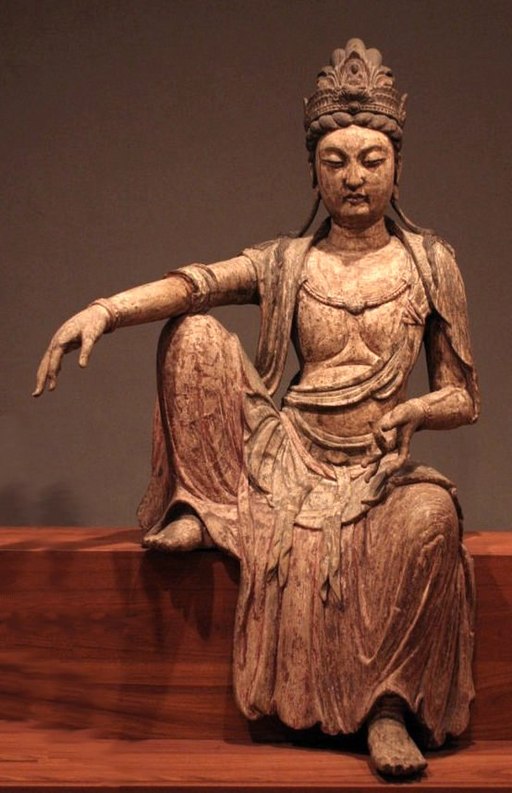
(Img is public domain)
The image above shows a wooden carving of the goddess Guanyin seated on a bench. Stern look upon her face, her legs apart; one foot on the floor and one foot on the bench upon which she sits. That is so like her.
I have read the wikipedia entry on Guanyin, it is an interesting read: Guanyin.
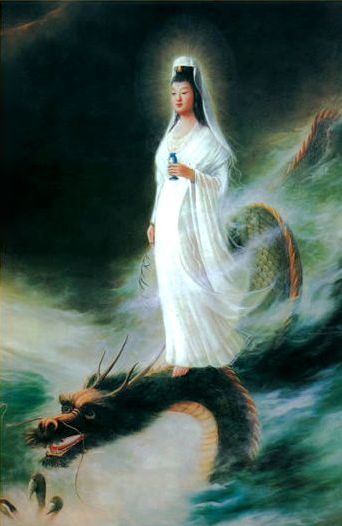
(Img is public domain)
The image above shows Guanyin standing upon a dragon ridding the sea waves.
Now dragons are so-called impossible mythical creatures. Some scholars say the proof of impossibilty is this; the dragon is obviously assembled from a number of other creatures.
Back in the beginning of this thread I described how a fairy can build itself a double of the human girl from the menses. In the story of Margaret and her little blue fairy, the fairy visited a wild pole cat and took the form of that animal to help Margaret. The little blue fairy bathed in the menses of the pole cat to do it.
So it is not difficult to understand that if a fairy visits many creatures, it can assemble itself a body such as the mythical dragon. So too the western dragons and chimeras.
Fairies can become many creatures using this principal. Humans are a new addition to the earth's population, and animals abounded for far longer.
One might suggest; Guanyin rides upon a 'fairy' . . .
Guanyin, by the way, collects the (deceased) spirits of children touched by the fairies. I get the impression that in the east the fairy girls are traditionally looked after, rather than culled as in the west.
In the east, these things are revered. In the west, the last two thousand years have been the demonisation and killing of legenadary Beings. "Saint" George is said to have killed the last dragon (or was it a fairy he killed? )
All I can really say, in my own opinion; a saint to some, a villain to others . . .
Now in the British Isles and old Europe, the fairies are considered to have the human form and said to have originated from the Tuath Dé Danann.
There is no reason to suggest that the Beings we call fairies would not, in other lands, have interest in things other than humans.
In a way, it is the Roman Catholic Church along with the modern Western occult tradition (hermeticism) that can be seen as not being particularly friendly towards the Beings that precede the modern "fairy". After all, the fairy is the ordinarily intangiable created avatar of Beings that come from outside six dimensional Euclidian space and time.
I think one should, in consideration of "religion", discriminate between the west and the east; the occident and the orient.
For example, in the triple image of Buddah and Shiva in the yoga lotus position, the soles of the feet are turned upwards while in meduitation. That says to me that Buddah and Shiva also walk with their feet upon the earth and all therein.
In the Roman Catholic symbol of the crucifix, those feet will never walk again, upon the surface of the earth.
In the orient, things are not seen as they are in the west. The goddess Guanyin, is said to be the goddess of compassion who rides upon a dragon.

(Img is public domain)
The image above shows a wooden carving of the goddess Guanyin seated on a bench. Stern look upon her face, her legs apart; one foot on the floor and one foot on the bench upon which she sits. That is so like her.
I have read the wikipedia entry on Guanyin, it is an interesting read: Guanyin.

(Img is public domain)
The image above shows Guanyin standing upon a dragon ridding the sea waves.
Now dragons are so-called impossible mythical creatures. Some scholars say the proof of impossibilty is this; the dragon is obviously assembled from a number of other creatures.
Further sources give variant lists of the nine animal resemblances. Sinologist Henri Doré lists these characteristics of an authentic dragon: "The antlers of a deer. The head of a crocodile. A demon's eyes. The neck of a snake. A tortoise's viscera. A hawk's claws. The palms of a tiger. A cow's ears. And it hears through its horns, its ears being deprived of all power of hearing." He notes that, "Others state it has a rabbit's eyes, a frog's belly, a carp's scales." The anatomy of other legendary creatures, including the chimera and manticore, is similarly amalgamated from fierce animals.
Source: wikipedia
Back in the beginning of this thread I described how a fairy can build itself a double of the human girl from the menses. In the story of Margaret and her little blue fairy, the fairy visited a wild pole cat and took the form of that animal to help Margaret. The little blue fairy bathed in the menses of the pole cat to do it.
So it is not difficult to understand that if a fairy visits many creatures, it can assemble itself a body such as the mythical dragon. So too the western dragons and chimeras.
Fairies can become many creatures using this principal. Humans are a new addition to the earth's population, and animals abounded for far longer.
One might suggest; Guanyin rides upon a 'fairy' . . .
Guanyin, by the way, collects the (deceased) spirits of children touched by the fairies. I get the impression that in the east the fairy girls are traditionally looked after, rather than culled as in the west.
In the east, these things are revered. In the west, the last two thousand years have been the demonisation and killing of legenadary Beings. "Saint" George is said to have killed the last dragon (or was it a fairy he killed? )
Saint George died 23 April 303, was a Christian who is venerated as a saint in Christianity. According to tradition he was a soldier in the Roman army. Saint George was a soldier of Cappadocian Greek origin and member of the Praetorian Guard for Roman emperor Diocletian, who was sentenced to death for refusing to recant his Christian faith. He became one of the most venerated saints and megalomartyrs in Christianity, and he has been especially venerated as a military saint since the Crusades.
Source: wikipedia
All I can really say, in my own opinion; a saint to some, a villain to others . . .
Now in the British Isles and old Europe, the fairies are considered to have the human form and said to have originated from the Tuath Dé Danann.
The Tuatha Dé Danann, meaning "the folk of the goddess Danu"), also known by the earlier name Tuath Dé ("tribe of the gods"), are a supernatural race in Irish mythology. They are thought to represent the main deities of pre-Christian Gaelic Ireland. The Tuatha Dé Danann constitute a pantheon whose attributes appeared in a number of forms throughout the Celtic world.
Source: wikipedia
There is no reason to suggest that the Beings we call fairies would not, in other lands, have interest in things other than humans.
In a way, it is the Roman Catholic Church along with the modern Western occult tradition (hermeticism) that can be seen as not being particularly friendly towards the Beings that precede the modern "fairy". After all, the fairy is the ordinarily intangiable created avatar of Beings that come from outside six dimensional Euclidian space and time.
edit on 4-3-2022 by NobodySpecial268 because: waffled on again, crap, look at the time. I gotta go to town!
I'll say from the outset that the persistant shared interactive dreamscapes are a haven for many people. The sense of belonging is important to the
human. The spiritual and religious, the corporate mind, the military person. We all like to belong to something and share being there with others.
Even to go to the karate or other club once a week and live within that dream for a time is a wonderful thing for us to do.
To step outside all these waking dreamscapes is very lonely, the feeling for me is to be utterly alone, and even I miss the collective dreams of my waking consciousness. Yet outside the dreamscapes you are not actually all alone. There are other Beings there in plenty. Among them are the so-called "gods" of mythology. They can enter or simply look into the persistant shared dreamscapes of their admirers.
One goddess showed me the persistant shared dreamscape her worshipers created with her assistance. While we looked at that place, she ran the back of her fingers across the surface of the boundary causing a ripple.
She said with some disdain: "look . . . . , I can make them dance . . . ."
. . . and they did.
The trick to do this with one's consciousness is to think in six dimensions. Height X width X length is our ordinary way of seeing and thinking of the world in three dimensions. Add the two dimensions of inside X outside and we think in five dimensions. A children's balloon is an example here; the balloon is a sphere, and every sphere has an inside and an outside. Thus a five dimensional object. The sixth dimension of motion is the art of relative positioning. Usually we are outside the balloon, were the balloon large enough, we could move from outside to be inside.
The trick here is to be able to move outside again at will. In and out needs to be practiced. A hint here is a simple lie we are told; "God is everything" is one such lie. The "universe" of the new-agers is another. As soon as we believe that we get stuck inside the sphere of the persistant shared dream.
The catholic church when viewed from outside is a yellow egg shaped coccoon; an egregore. The physical cathedrals and minor churches anchor it within the physical.
This is also true of the persistant shared interactive dreamscapes.
The seventh dimension, which should really be called time, is also there. Movement and motion are not really (in practice anyway) the same thing as linear time with it's "what has been".
Earlier in the thread, the subject of asymmetric warfare (unconventional strategies and tactics) was discussed. This was in relation to the fairy folk of the British Isles, and the children touched by the fae. I think I may have finally found at least some of them.
The Inquisitions are well known, the torture and executions. My perception of the inquisition is the process is entirely psychological. The confession, renunciation and conversion to church. The psychology of torture is well known in certain circles and often spoken of here on ATS.
Confession is the acknowledgment of sins or wrongs. ("sins" in someone else's eyes.)
Renounciation is the act of rejecting something, especially if it is something that the renunciant has previously enjoyed or endorsed.
Conversion is the adoption of a set of beliefs identified with one particular religious denomination to the exclusion of others.
When one knows the fairies and loves them and has the knowledge and the sight, the inquisition is clearly designed as betrayal of oneself and one's friends; the betrayal of what one knows to be true. The conversion to the percieved enemy ranks is shall we say; soul destroying.
The healing of deceased touched by the fae children is very much a psychological healing. The healing of the traumas of the past. It is also a healing of the primary memory, the blue snowflake memory that has the memories of many lives. The deep traumas are there in the snowflake.
Yet we do need to go deeper in the case of these traumatised children. When there was forced conversion to the church, there is sometimes an identification with certain spiritual concepts.
I have mentioned that the human is a triplicity; the primary snowflake memory, the subconscious aspect and the conscious aspect (from the point of view of our waking consciousness).
There is also a triple principal in the church that often appears in symbolism elsewhere. The church calls it the trinity.
In a few of my deceased girls, one had to unlink the deep seated created belief of the triplicity being the same as the church's trinity to free them from the church. It can be done, and the resulting freedom and subsequent change in the deceased child is amazing to see. I am reminded of when one of my deceased girls, in a moment of frustration with my not understanding, appeared close to my face, lifted her (hair) bangs with a hand and angrily pointed her finger at a mark upon her forehead. The mark was a letter 'L' looking device. Perhaps the Hebrew letter Lamedh. In any case, the mark on the deceased girl's forehead marked her as one to be culled.
My own view now is the "L" is the letter lamedh with it's association with the sheppard's crook, and has it's origin in marking these deceased children for culling and the darker side of the Kabbalah.
All these things we have had to remove, and even the baptism can be undone for these kids.
The acts of the religious institution can be seen and work on the physical and psychological level, that be our everyday conscious world.
There is another "level".
Where the religion works in the open, something else works behind closed doors.
It is said in the Greek mythology, that the Titan Prometheus stole fire from the gods and gave it to humanity.
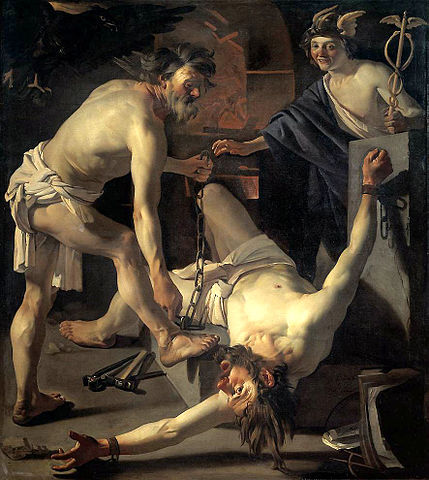
(Img is public domain. Prometheus Being Chained by Vulcan, an oil painting of 1623 by Dirck van Baburen.)
Like Prometheus and fire, the Roman god Mercury, also known as Hermes Trismegistus, is said to have given humanity the hermetic arts.
The persistant shared interactive dreamscape I described earlier of the university with twin staircases bathed in golden light, where sleeping (and deceased) folks go to study, has it's infrastructure based on the staff of Mercury/Hermes.
The people who go there learn the hermetic arts behind closed doors.
The hermetic arts and that university, have a dark lower aspect.
To step outside all these waking dreamscapes is very lonely, the feeling for me is to be utterly alone, and even I miss the collective dreams of my waking consciousness. Yet outside the dreamscapes you are not actually all alone. There are other Beings there in plenty. Among them are the so-called "gods" of mythology. They can enter or simply look into the persistant shared dreamscapes of their admirers.
One goddess showed me the persistant shared dreamscape her worshipers created with her assistance. While we looked at that place, she ran the back of her fingers across the surface of the boundary causing a ripple.
She said with some disdain: "look . . . . , I can make them dance . . . ."
. . . and they did.
The trick to do this with one's consciousness is to think in six dimensions. Height X width X length is our ordinary way of seeing and thinking of the world in three dimensions. Add the two dimensions of inside X outside and we think in five dimensions. A children's balloon is an example here; the balloon is a sphere, and every sphere has an inside and an outside. Thus a five dimensional object. The sixth dimension of motion is the art of relative positioning. Usually we are outside the balloon, were the balloon large enough, we could move from outside to be inside.
The trick here is to be able to move outside again at will. In and out needs to be practiced. A hint here is a simple lie we are told; "God is everything" is one such lie. The "universe" of the new-agers is another. As soon as we believe that we get stuck inside the sphere of the persistant shared dream.
The catholic church when viewed from outside is a yellow egg shaped coccoon; an egregore. The physical cathedrals and minor churches anchor it within the physical.
This is also true of the persistant shared interactive dreamscapes.
The seventh dimension, which should really be called time, is also there. Movement and motion are not really (in practice anyway) the same thing as linear time with it's "what has been".
Earlier in the thread, the subject of asymmetric warfare (unconventional strategies and tactics) was discussed. This was in relation to the fairy folk of the British Isles, and the children touched by the fae. I think I may have finally found at least some of them.
The Inquisitions are well known, the torture and executions. My perception of the inquisition is the process is entirely psychological. The confession, renunciation and conversion to church. The psychology of torture is well known in certain circles and often spoken of here on ATS.
Confession is the acknowledgment of sins or wrongs. ("sins" in someone else's eyes.)
Renounciation is the act of rejecting something, especially if it is something that the renunciant has previously enjoyed or endorsed.
Conversion is the adoption of a set of beliefs identified with one particular religious denomination to the exclusion of others.
When one knows the fairies and loves them and has the knowledge and the sight, the inquisition is clearly designed as betrayal of oneself and one's friends; the betrayal of what one knows to be true. The conversion to the percieved enemy ranks is shall we say; soul destroying.
The healing of deceased touched by the fae children is very much a psychological healing. The healing of the traumas of the past. It is also a healing of the primary memory, the blue snowflake memory that has the memories of many lives. The deep traumas are there in the snowflake.
Yet we do need to go deeper in the case of these traumatised children. When there was forced conversion to the church, there is sometimes an identification with certain spiritual concepts.
I have mentioned that the human is a triplicity; the primary snowflake memory, the subconscious aspect and the conscious aspect (from the point of view of our waking consciousness).
There is also a triple principal in the church that often appears in symbolism elsewhere. The church calls it the trinity.
In a few of my deceased girls, one had to unlink the deep seated created belief of the triplicity being the same as the church's trinity to free them from the church. It can be done, and the resulting freedom and subsequent change in the deceased child is amazing to see. I am reminded of when one of my deceased girls, in a moment of frustration with my not understanding, appeared close to my face, lifted her (hair) bangs with a hand and angrily pointed her finger at a mark upon her forehead. The mark was a letter 'L' looking device. Perhaps the Hebrew letter Lamedh. In any case, the mark on the deceased girl's forehead marked her as one to be culled.
My own view now is the "L" is the letter lamedh with it's association with the sheppard's crook, and has it's origin in marking these deceased children for culling and the darker side of the Kabbalah.
All these things we have had to remove, and even the baptism can be undone for these kids.
The acts of the religious institution can be seen and work on the physical and psychological level, that be our everyday conscious world.
There is another "level".
Where the religion works in the open, something else works behind closed doors.
It is said in the Greek mythology, that the Titan Prometheus stole fire from the gods and gave it to humanity.

(Img is public domain. Prometheus Being Chained by Vulcan, an oil painting of 1623 by Dirck van Baburen.)
The painting represents a tale from Greco-Roman mythology. Mercury, the messenger of the gods, watches the club-footed blacksmith god, Vulcan, punish the bold and cunning Titan Prometheus for stealing fire from the gods and giving it to mortals. Prometheus's punishment is to be bound to a rock and to have his liver consumed daily by an eagle.
Source: wikipedia
Like Prometheus and fire, the Roman god Mercury, also known as Hermes Trismegistus, is said to have given humanity the hermetic arts.
Hermes Trismegistus "Hermes the Thrice-Greatest" is a legendary Hellenistic figure that originated as a syncretic combination of the Greek god Hermes and the Egyptian god Thoth. He is the purported author of the Hermetica, a widely diverse series of ancient and medieval pseudepigraphical texts that lay the basis of various philosophical systems known as Hermeticism.
Source: wikipedia
The persistant shared interactive dreamscape I described earlier of the university with twin staircases bathed in golden light, where sleeping (and deceased) folks go to study, has it's infrastructure based on the staff of Mercury/Hermes.
The people who go there learn the hermetic arts behind closed doors.
The hermetic arts and that university, have a dark lower aspect.
edit on 6-3-2022 by NobodySpecial268 because: enlarged explanations and fixed quite a few typos.
Before I take the reader on a tour of the hermetic university's lower world, I need to explane an important principal of the construction of the large
interactive shared dreamscapes.
In the human consciousness I described the inversion of consciousness between asleep and awake. The image below shows the figure eight on it's side. The two flower forms within the two joining circles.

Now in the large interactive shared dreamscapes, there is a different principal at work. Rather than inversion, we have separation.
So let's take the image of a children's balloon.

One might say that the balloon is a simple dream. Our subconscious creates the simple dream. We may say this is a natural and simple template of construction. The circle in five dimensions.
Now let's take our balloon in our hands and put a twist in it, making two joined spheres. Our figure eight in five dimensions, shown in the image below.

So we can have two separate yet joined interactive shared dreamscapes without the inversion of consciousness. If we want to, we can say "above and below", "heaven and hell", or whatever. The fact remains that the two spheres are joined and were once a single sphere.
This can happen when we have the "good and evil" and "light and darkness" dualistic thinking.
In contrast to the dualistic, in the human child is happiness as the natural state of being. The accumulation of misery creates the darkness.
There is a difference . . .
So in our hermetic interactive shared dreamscape we could have a single spherical dreamscape equivalent to the state of happiness in the child.
Yet instead of the single sphere, we have two conjoined (twin) dreamscapes. Conjoined is the proper term as far as I can assertain from observation.
One conjoined twin is where the "good" is concentrated. The other conjoined twin is, well, it is where the dirty laundry is kept, along with the black ops. There are also people there, deceased and sleeping who you really do not want to meet. As such it is a place of misery. I know because I spend time in there. It is an interesting study.
Now before I decribe this particular hermetic dreamscape, I will say this: never assume there is only one of anything. This particular dreamscape is probably not the only one that practices hermeticism. One should not assume that all hermetic dreamscapes (if there are any more) are of the conjoined twin design.
In the human consciousness I described the inversion of consciousness between asleep and awake. The image below shows the figure eight on it's side. The two flower forms within the two joining circles.

Now in the large interactive shared dreamscapes, there is a different principal at work. Rather than inversion, we have separation.
So let's take the image of a children's balloon.

One might say that the balloon is a simple dream. Our subconscious creates the simple dream. We may say this is a natural and simple template of construction. The circle in five dimensions.
Now let's take our balloon in our hands and put a twist in it, making two joined spheres. Our figure eight in five dimensions, shown in the image below.

So we can have two separate yet joined interactive shared dreamscapes without the inversion of consciousness. If we want to, we can say "above and below", "heaven and hell", or whatever. The fact remains that the two spheres are joined and were once a single sphere.
This can happen when we have the "good and evil" and "light and darkness" dualistic thinking.
In contrast to the dualistic, in the human child is happiness as the natural state of being. The accumulation of misery creates the darkness.
There is a difference . . .
So in our hermetic interactive shared dreamscape we could have a single spherical dreamscape equivalent to the state of happiness in the child.
Yet instead of the single sphere, we have two conjoined (twin) dreamscapes. Conjoined is the proper term as far as I can assertain from observation.
One conjoined twin is where the "good" is concentrated. The other conjoined twin is, well, it is where the dirty laundry is kept, along with the black ops. There are also people there, deceased and sleeping who you really do not want to meet. As such it is a place of misery. I know because I spend time in there. It is an interesting study.
Now before I decribe this particular hermetic dreamscape, I will say this: never assume there is only one of anything. This particular dreamscape is probably not the only one that practices hermeticism. One should not assume that all hermetic dreamscapes (if there are any more) are of the conjoined twin design.
A prolog.
(Shesha is a Nagi, a snake goddess by the way.)
The fairy realms are said in the folk lore to be underground too.
There is a place I like to visit. It is, I spose, what one might call an "underworld". I call it that as, well, it is a place below ground. Nothing grows down there. Nearly everything is dead.
There are plains, and tall glassy mountains coloured with a hint of sulphurous yellow in the distance.
Sulphurous yellow. Here is a hint: "The fire and brimestone of hell . . . " - brimstone being sulphur, is the threat of the preacher to sinners. We all know fire is a sterilizer, and well, we still make antibiotics from sulphur. I wonder, is fire and brimstone really a threat?
If used with care, fire and brimstone would probably heal the sinner . . . (just a little bit of logic ; )
There also a lake. The waters are full of the bodily fluids of decay and one can make out the remains of people.
The black sky is criss crossed with yellow lines in a grid pattern. Perhaps "ley" lines or some such thing. The lines bend downwards as if a wire frame box. The hell of a church, probably a cathedral, pushes the yellow lines down. Hells are local things found below churches and similar buildings.
The head waters of the lake are where some elf-ish beings gave me two deceased human children, "Jennifer and Edward" . They would not last long apparently. They were afflicted by the congenital syphilis. They were my first deceased pediatric patients.
I like this world for some reason. Perhaps because it is so quiet here, I don't hear the cacophony of human (thought?) voices.
I have the distinct impression this was once a beautiful place.
----------
Below is a diagram of the persistant shared interactive dream of the hermeticists.
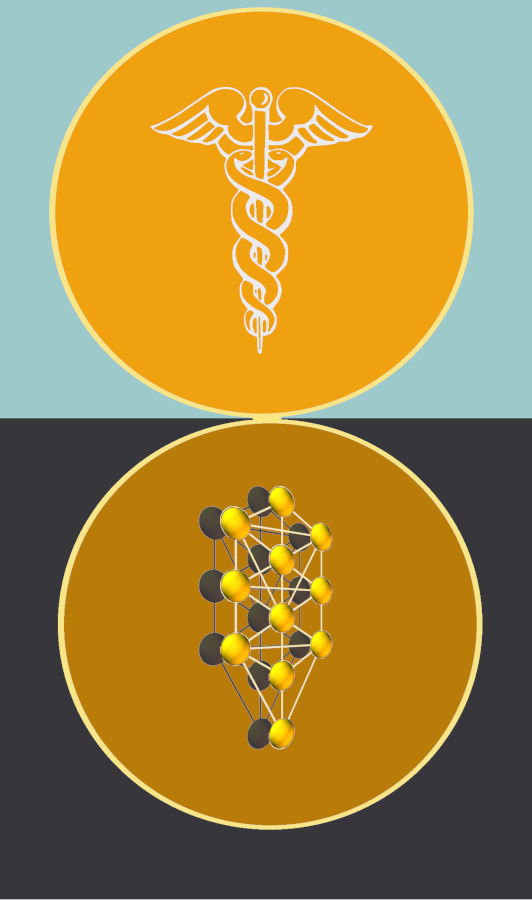
The upper half is blue, as in sky. The lower half is dark and is to illustrate above and below ground. Above ground is the sphere containing the staff of Hermes, that is the "university". Below ground is the second dream sphere containing the two trees of the kabbalah. The light tree and the dark tree, the dark tree often called "the realm of husks and rinds".
One of my first observations was to notice the matching sephirot of the dark and light trees are conjoined twins. The very same structure as the two conjoined dreams that contain the staff and the tree. This place is not natural, it is constructed.
Perhaps an educated guess, but I get the distinct impression the "spiritual" dream sphere preceded the darker dream sphere. The dark conjoined twin being extruded from the first. So too the two trees of the kabbalah. I am just the oberserver here, and not a mystic scholar.
What is above ground is probably a shining spiritualistic place of learning for the dreamers and the dead.
What is within the below ground sphere is certainly not.
In Indian religions, Patala (that which is below the feet), denotes the subterranean realms of the universe – which are located under the earthly dimension. Patala is often translated as underworld or netherworld. Patala is described as more beautiful than Svarga (subtle dimensions, loosely translated as heaven). Patala is described as filled with splendid jewels, beautiful groves and lakes.
(above) The legs of the god Vishnu depicting earth and the six realms of Patala. The feet rest on Shesha.
Source: wikipedia patala
(Shesha is a Nagi, a snake goddess by the way.)
The fairy realms are said in the folk lore to be underground too.
There is a place I like to visit. It is, I spose, what one might call an "underworld". I call it that as, well, it is a place below ground. Nothing grows down there. Nearly everything is dead.
There are plains, and tall glassy mountains coloured with a hint of sulphurous yellow in the distance.
Sulphurous yellow. Here is a hint: "The fire and brimestone of hell . . . " - brimstone being sulphur, is the threat of the preacher to sinners. We all know fire is a sterilizer, and well, we still make antibiotics from sulphur. I wonder, is fire and brimstone really a threat?
If used with care, fire and brimstone would probably heal the sinner . . . (just a little bit of logic ; )
There also a lake. The waters are full of the bodily fluids of decay and one can make out the remains of people.
The black sky is criss crossed with yellow lines in a grid pattern. Perhaps "ley" lines or some such thing. The lines bend downwards as if a wire frame box. The hell of a church, probably a cathedral, pushes the yellow lines down. Hells are local things found below churches and similar buildings.
The head waters of the lake are where some elf-ish beings gave me two deceased human children, "Jennifer and Edward" . They would not last long apparently. They were afflicted by the congenital syphilis. They were my first deceased pediatric patients.
I like this world for some reason. Perhaps because it is so quiet here, I don't hear the cacophony of human (thought?) voices.
I have the distinct impression this was once a beautiful place.
----------
Below is a diagram of the persistant shared interactive dream of the hermeticists.

The upper half is blue, as in sky. The lower half is dark and is to illustrate above and below ground. Above ground is the sphere containing the staff of Hermes, that is the "university". Below ground is the second dream sphere containing the two trees of the kabbalah. The light tree and the dark tree, the dark tree often called "the realm of husks and rinds".
One of my first observations was to notice the matching sephirot of the dark and light trees are conjoined twins. The very same structure as the two conjoined dreams that contain the staff and the tree. This place is not natural, it is constructed.
Perhaps an educated guess, but I get the distinct impression the "spiritual" dream sphere preceded the darker dream sphere. The dark conjoined twin being extruded from the first. So too the two trees of the kabbalah. I am just the oberserver here, and not a mystic scholar.
What is above ground is probably a shining spiritualistic place of learning for the dreamers and the dead.
What is within the below ground sphere is certainly not.
edit on 9-3-2022 by NobodySpecial268 because: neatness
new topics
-
Islam And A Book Of Lies
Religion, Faith, And Theology: 8 minutes ago -
Sorry to disappoint you but...
US Political Madness: 2 hours ago -
Watch as a 12 million years old Crab Emerges from a Rock
Ancient & Lost Civilizations: 7 hours ago
top topics
-
Speaking of Pandemics
General Conspiracies: 16 hours ago, 9 flags -
ILLUMINATION: Dimensions / Degrees – Da Vincis Last Supper And The Philosophers Stone
Secret Societies: 13 hours ago, 9 flags -
Watch as a 12 million years old Crab Emerges from a Rock
Ancient & Lost Civilizations: 7 hours ago, 9 flags -
Just Sick of It! Done! Can't take it anymore!
General Chit Chat: 14 hours ago, 8 flags -
Sorry to disappoint you but...
US Political Madness: 2 hours ago, 6 flags -
Stuck Farmer And His Queue Jumping Spawn
Rant: 16 hours ago, 4 flags -
Islam And A Book Of Lies
Religion, Faith, And Theology: 8 minutes ago, 0 flags
active topics
-
Joe Biden gives the USA's Highest Civilian Honor Award to Hillary Clinton and George Soros.
US Political Madness • 44 • : Dalamax -
Islam And A Book Of Lies
Religion, Faith, And Theology • 0 • : charlest2 -
Tesla Cybertruck Explodes in Front of Trump Hotel in Las Vegas
Mainstream News • 227 • : WeMustCare -
Musk calls on King Charles III to dissolve Parliament over Oldham sex grooming gangs
Mainstream News • 178 • : Oldcarpy2 -
Bin Cyber Junk…
Short Stories • 5 • : FullHeathen -
Sorry to disappoint you but...
US Political Madness • 6 • : KrustyKrab -
-@TH3WH17ERABB17- -Q- ---TIME TO SHOW THE WORLD--- -Part- --44--
Dissecting Disinformation • 3946 • : WeMustCare -
Just Sick of It! Done! Can't take it anymore!
General Chit Chat • 14 • : Flyingclaydisk -
What Is 'Quad Demic'? Mask Mandate Returns In These US States
Diseases and Pandemics • 38 • : NorthOS -
Winter Storm
Fragile Earth • 32 • : Irishhaf

